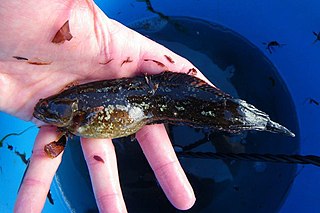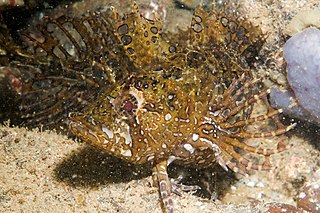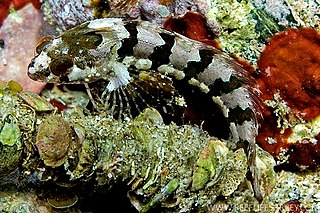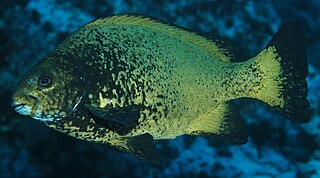
The mullets or grey mullets are a family (Mugilidae) of ray-finned fish found worldwide in coastal temperate and tropical waters, and some species in fresh water. Mullets have served as an important source of food in Mediterranean Europe since Roman times. The family includes about 78 species in 26 genera.

Atherinomorus is a genus of silversides in the family Atherinidae.
Nannoperca or pygmy perch is a genus of temperate perches endemic to freshwater systems of Australia.

Lepidotrigla is a genus of marine ray-finned fishes belonging to the family Triglidae, the gurnards and sea robins. These gurnards are found in the Eastern Atlantic, Indian and Western Pacific Oceans.
Heteroclinus antinectes, the Natal weedfish, is a species of clinid found in the Indian Ocean waters off of Australia. It is endemic to Shark Bay in Western Australia.
Heteroclinus eckloniae, the Kelp weedfish, is a species of clinid native to the Indo-Pacific waters of the western and southern coasts of Australia where it can be found in kelp and algal reefs. This species can reach a maximum length of 11 centimetres (4.3 in) TL.
Heteroclinus equiradiatus, the Sevenbar weedfish, is a species of clinid native to the Indian Ocean coast of western Australia. This species can reach a maximum length of 9.7 centimetres (3.8 in) TL.

The short-tassel weedfish is a species of clinid native to the Pacific Ocean waters around the Bass Strait and New Zealand. This species are known to feed on fishes and benthic crustaceans. It is the only species in its genus. Klunzinger's name, Clinus marmoratus, is a homonym and was preoccupied by Castelnau's Clinus marmoratus, rendering it invalid for this fish and this name is now considered to be a junior synonym of Cologrammus flavescens.
Heteroclinus kuiteri, or Kuiters weedfish, is a species of clinid native to the Indian Ocean coast of Australia.
Heteroclinus macrophthalmus, the large-eye weedfish, is a species of clinid native to Indian Ocean waters around southern Australia where it prefers beds of sea-grass and algal reefs down to a depth of about 18 metres (59 ft). This species can reach a maximum length of 10 centimetres (3.9 in) TL.
Heteroclinus nasutus, the large-nose weedfish, is a species of clinid that is found in the waters of the Pacific Ocean coast of Australia where it prefers algae covered rocky outcrops along the coast down to a depth of about 10 metres (33 ft). This species can reach a maximum length of 9 centimetres (3.5 in) TL.
Heteroclinus puellarum, the little weedfish, is a species of clinid found on the Indian Ocean coast of southeastern Australia where it can be found in tide pools, rocky reefs and estuaries. This species can reach a maximum length of 10 centimetres (3.9 in) TL.

Heteroclinus roseus, the Rosy weedfish, is a species of clinid native to the Pacific Ocean coasts around Japan, Australia and Vanuatu, where it lives in coastal belts of seaweed. This species can reach a maximum length of 15 centimetres (5.9 in) TL.

Heteroclinus tristis, the sharp-nose weedfish, is a species of clinid native to the coastal waters of southern Australia where it prefers sandy reefs with sparse vegetation. This species can reach a maximum length of 30 centimetres (12 in) TL. This species feed primarily fishes, shrimp and prawns.

Heteroclinus whiteleggii, Whitelegg's weedfish, is a species of clinid native to reefs around New South Wales, Australia. This species can reach a maximum length of 10 centimetres (3.9 in) TL. The specific name honours the naturalist Thomas Whitelegge (1850-1927) who was a friend of Ogilby's friend and who collected the type.
Heteroclinus wilsoni, or Wilson's weedfish, is a species of clinid found along the coast of southern Australia and Tasmania where it can be found in weedy reefs from the intertidal zone down to a depth of about 20 metres (66 ft). This species can reach a maximum length of 14 centimetres (5.5 in) TL. The specific name honours John Bracebridge Wilson (1828-1895), a naturalist and headmaster who collected the type.

Girella is a genus of sea chubs mostly native to the Pacific Ocean with a smaller presence in the Atlantic oceans.

Paraplesiops is a genus containing five largely allopatric species of fishes in the longfin, or roundhead, family Plesiopidae, commonly known as blue devils, bluedevils, or blue devilfish because of their colouration. The genus is most similar to the tropical genera Plesiops and Fraudella. It is restricted to subtropical and temperate rocky and coral reefs in Australian waters. Its species are mostly cryptic, occurring in submarine caves, crevices and under rocky ledges.

The scaldfishes comprise a genus, Arnoglossus, of lefteye flounders. They are found in the Pacific, Indian and Atlantic Oceans, including the Mediterranean and Black Sea. They are entirely absent from most of the Americas; the only exceptions are A. coeruleosticta and A. multirastris found off Chile. The genus include both species found in shallow and deeper water. The largest species reaches 28 cm (11 in).

Nesogobius is a genus of goby native to the coastal waters of Australia.











